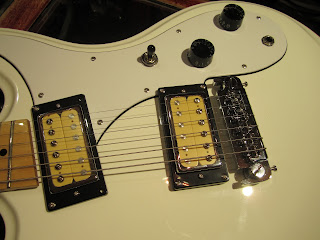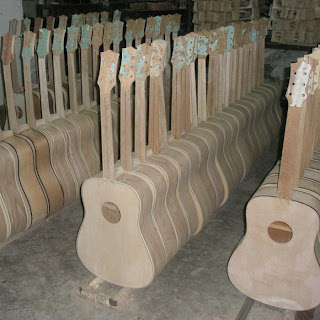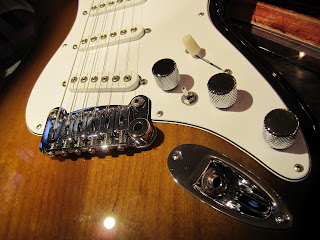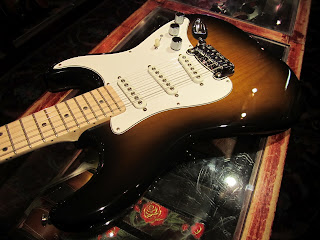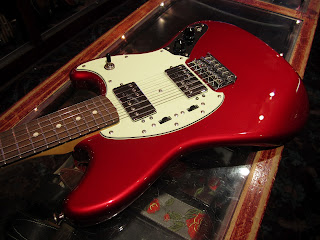Last winter I had the pleasure of meeting Mr. Druery and his wife in the shop, while they were on vacation. He brought in a model for me to look at and I was instantly enamored with it. A few months later, we had one in the shop, and it sold the next day. So now here were are with two of his guitars, both of which are out of this world.
Being a native New Zealander, all the woods used in these guitars are indigenous. Names like Kahikatea, Heart Rimu, and Kauri will confound most guitar players here in the states, but all it means is you have to take the time to listen again and discover what these woods do tonally. One of the most appealing aspects of these guitars is the fact that they are made from wood you cannot find here in the U.S. Everybody and their mother has an acoustic guitar with rosewood, spruce, cedar and the like. Not so easy to find that guitar with a Kauri top! There are many models to choose from, but the two we have in the shop and will focus on here are the "Roreka" and the "Kauri".
The "Roreka" is a small body guitar, whose name means "Sweet singing". And sweetly she does sing! Featuring a Kahikatea top, heart rimu back and sides, matai neck and puriri fretboard and bridge. To give you a general idea, Kahikatea has a similar appearance to adirondack spruce, and rimu has a color similar to mahogany but with a more crisp, bright tone. The guitar features an additional side soundport, which not only allows the player to hear a bit more of themselves but gives the overall guitar a slightly different sound to the listener. The rosette features a gorgeous inlay of baby paua shells and ancient kauri leaf, lending more to the nature inspired vibe this beautiful little guitar has. The sound of the instrument has a nice bright punch to it, but not in an aggressive way. I've always found Taylor guitars to be too bright to handle, but this guitar manages to have that crispness without the obnoxious high end. While the "Roreka" does not have a lot of low end on tap, it does offer a well balanced sound that can handle everything from fingerpicking to strumming. For being a small bodied guitar it also offers a good volume, and can go toe to toe with a dreadnought very easily.
The "Kauri" is one of the newer models Mr. Druery offers, and it has fast become my favorite acoustic guitar in the shop. One is immediately grabbed to it's attention by the unique off set soundhole. While you may think this will limit the volume or tone of the guitar, you would be proven wrong very fast! There's loads of volume available here, and with the added side soundport you've got tone to boot! Similar to the "Roreka", this guitar features heart rimu back and sides, but sports a recycled Kauri top. This wood has had many lives, since it was cut down in the early part of last century. A northland timber mill, floor joists of a bank in Dunedin just to name a few! It has a wood grain that is beautiful to behold but not over stated either. The tone will be similar to koa or walnut, but I'd say let your own ears do the deciding! In contrast to the "Roreka", this guitar adds a fantastic low end to the crispness, and when you're thumping away on the bottom strings you can certainly feel it. In both strumming and picking this guitar sounds amazing, and to seal the deal it will look unforgettable to your audience at your next gig!
The excellence of this guitars doesn't cease with just the design and sound. All the Kauri that Mr. Druery uses is 100% recycled, and he donates a portion of the guitar profits back to replanting efforts in New Zealand in the customers name. So not only do you get a killer guitar, but you help the environment! (now you can enjoy the guitar with a clear conscience!) In addition to that, you get a USB stick with photos of the guitar build, giving the consumer a rare glimpse into the process of putting a guitar together. It's also a remarkable bit of transparency that you seldom find in modern guitar builders.
I will flat out admit I love these guitars. I find them all at once aesthetically simple and beautiful, and completely on their own in sound and feel. They have an excellent story to tell, and are carefully handcrafted by a builder who cares where they go and what becomes of them. It's hard to find acoustic guitars that break out of the pack and stand on their own, but if thats what you've been looking for then a Christian Druery guitar will fit the bill nicely.
Below I have posted a video of both guitars. Big thanks to Rob Hickey, my acoustic specialist for the playing. The "Roreka" model sells for $2799, and the "Kauri" for $2899. (less than the more pricey Taylor models, and far more unique!) Both come with SKB molded cases and feature a limited 12 month warranty. Check out the website for the other models here. More than ever I encourage you to come by Rudy's and play one of these before they are gone!
Please sign up to follow my blog via email at the top right hand corner of the page! And feel free to comment!
K.



















